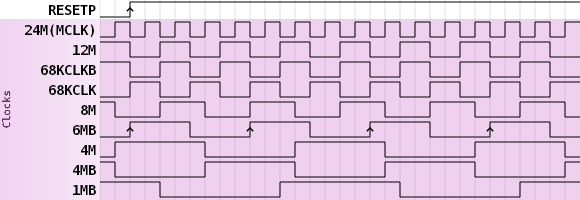Clock: Difference between revisions
m (→In CD systems) |
m (→Signals) |
||
| Line 23: | Line 23: | ||
==Signals== | ==Signals== | ||
{{Sig|24M|24M}}, {{Sig|12M|12M}}, {{Sig|68KCLK|68KCLK}}, {{Sig|68KCLKB|68KCLKB}}, {{Sig|8M|8M}}, {{Sig|6MB| | {{Sig|24M|24M}} (~24MHz), {{Sig|12M|12M}} (12MHz), {{Sig|68KCLK|68KCLK}} (12MHz), {{Sig|68KCLKB|68KCLKB}} (12MHz), {{Sig|8M|8M}} (8MHz), {{Sig|6MB|6MB}} (6MHz), {{Sig|4M|4M}} (12MHz), {{Sig|4MB|4MB}} (4MHz), {{Sig|1MB|1MB}} ('''3MHz''') | ||
=In CD systems= | =In CD systems= | ||
Revision as of 11:29, 30 September 2016
Not to be confused with the real time clock (RTC), which is clocked independently.
In cartridge systems
The main system clock (often called mclk) is either 24MHz (MVS) or 24.167829MHz (AES). It is generated and divided by 2, 4 and 8 by NEO-D0 from a crystal oscillator, to provide the 12MHz clock for NEO-ZMC2, the inverted 6MHz one for video output and also the 3MHz one for NEO-B1.
LSPC2-A2 divides it by 3 and 6 to provide the 8MHz clock for the YM2610 and the 4MHz one for the Z80.
The cartridge connector provides the 24MHz, 12MHz, 8MHz and 4MHz inverted clock signals.
A second quartz oscillator is used for generating the color burst needed by composite video, for the video encoders.
A third 32768Hz quartz oscillator is used for the RTC.
Phase relations
Signals
24M (~24MHz), 12M (12MHz), 68KCLK (12MHz), 68KCLKB (12MHz), 8M (8MHz), 6MB (6MHz), 4M (12MHz), 4MB (4MHz), 1MB (3MHz)
In CD systems
NEO-GRC ?

